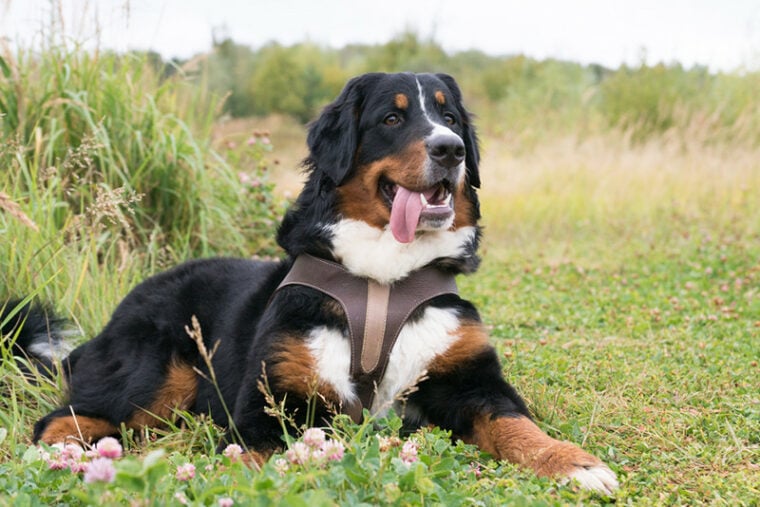
Click to Skip Ahead
There are hundreds of dog breeds out there, and they’re all different. Some pups are heavy shedders; others can’t seem to stop barking. And there we have the dogs that droop all over. When left unattended, these buds will ruin your favorite rugs, chairs, and, of course, the couch. And keeping the drooling under control is no small task!
Can’t stand the thought of having to clean up a slobbery mess every other day? Then the best thing you can do is get a dog that doesn’t drool much. Or, better yet, know which breeds to avoid. The following list includes the 14 messiest canines that salivate like their life depends on it. Take a look!
How Are Drooling Dogs Classified?
Why do some pups salivate heavily, while others don’t? It has to do with the physical features of the breed (i.e., their jowly cheeks and heavy lips). From Mother Nature’s perspective, drool is nothing to be worried about; it’s the saliva that builds up inside the pup’s mouth and helps with digestion. And most dogs only drool when excited, anxious, or about to have a feast.
This doesn’t apply to Newfies, Danes, or Saint Bernards, though. By default, they produce more saliva and have larger upper lips/flews that do very little to stop the spittle flow. Furthermore, the extra skin around the muzzle (the jowls) serves as “storage” for the saliva. And when these gentle giants get excited, that causes some serious drooling.
The 14 Dogs That Drool The Most
1. Bloodhound
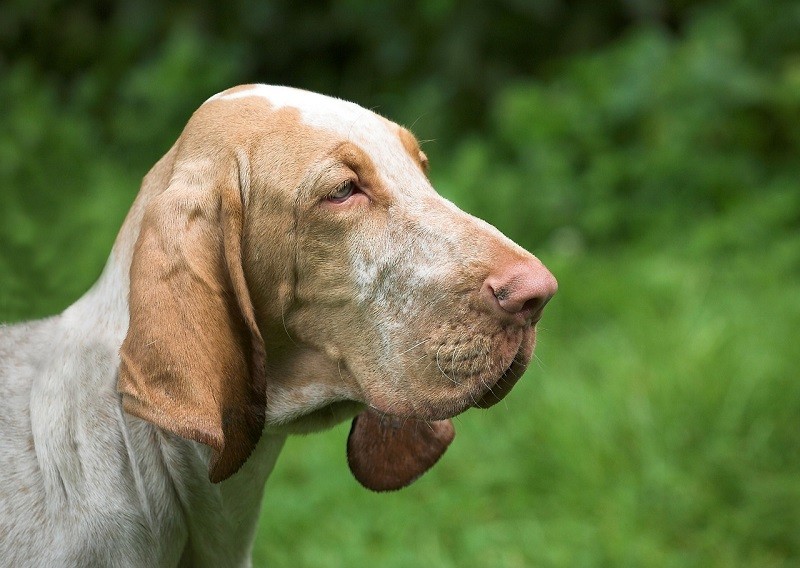
| Origin: | UK, Belgium, France |
| Lifespan: | 10–12 years |
| Height: | 23–27 inches |
| Weight: | 80–110 pounds |
| Drooling Level: | 5/5 |
Let’s start the list of the biggest drool offenders with the Bloodhound, a gifted sleuth from Dog Realm. Independent and incredibly smart, these pups have a “golden” nose that can catch a scent from miles away. Bred for hunting game (rabbits, deer, and boars), they are laser-focused when there’s a task at hand. Unfortunately, Bloodhounds are also quite the droolers.
They like to hang out on the couch or the carpet, and that’s when the dribbling starts. These dogs have deep lips that produce/contain high volumes of saliva.
2. Dogue de Bordeaux
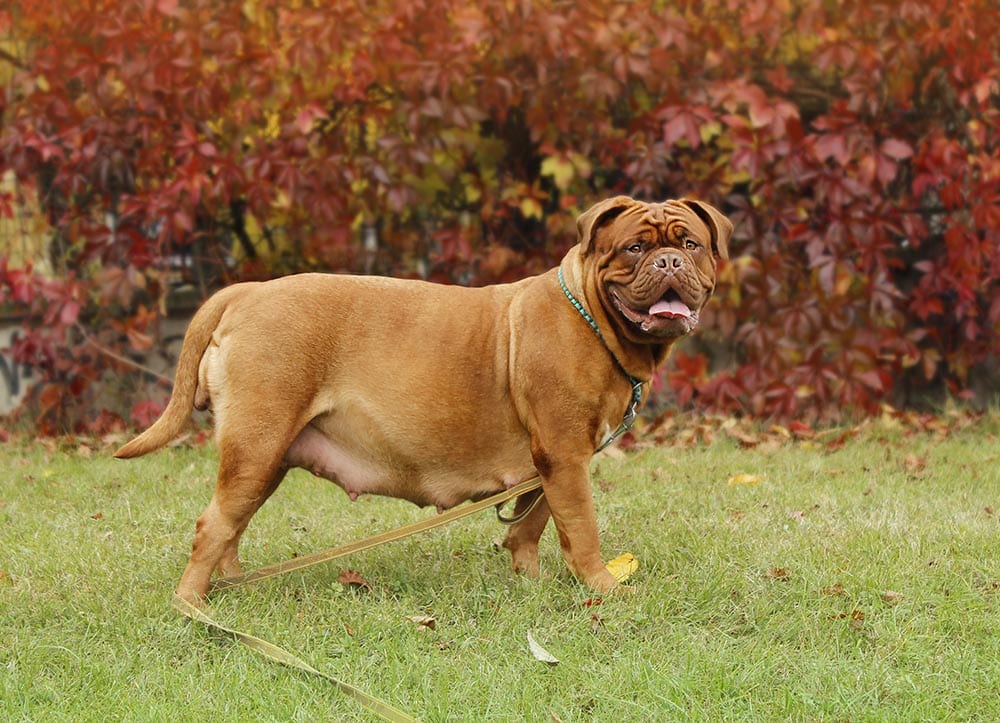
| Origin: | France |
| Lifespan: | 5–8 years |
| Height: | 23–27 inches |
| Weight: | 99–110 pounds |
| Drooling Level: | 5/5 |
Hailing from France, this massive, imposing dog is renowned for its brave, loyal heart, and affectionate nature. The French Mastiff is an elite guardian with a huge head that makes the canine look a bit like a Bulldog. Yes, it’s a faithful and capable friend, yet can be stubborn and requires lots of obedience training. And don’t get us started on the drooling!
Dogue de Bordeaux “marks the territory” with saliva all the time and needs the wrinkles cleaned daily. But, that’s a normal thing for brachycephalic pups.
3. Saint Bernard
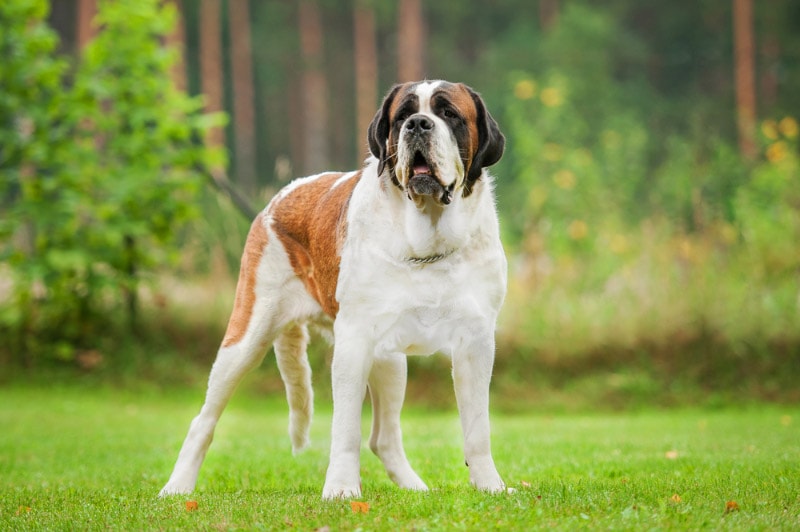
| Origin: | Switzerland |
| Lifespan: | 8–10 years |
| Height: | 26–30 inches |
| Weight: | 120–180 pounds |
| Drooling Level: | 5/5 |
Are you in the market for a big, exceptionally strong protector? Then look no further! Saints are known for their playful, sweet, and alert character. On top of that, Saint Bernards can be very patient and tolerant. However, these Swiss Alp natives also drool excessively when stressed, excited, or before and after a meal. This also happens when the dogs are close to overheating.
Like any other breed with ties to the Mastiffs, Saints have a disproportionately large head, shorter-than-average muzzle, and wrinkled brow.
4. Newfoundland
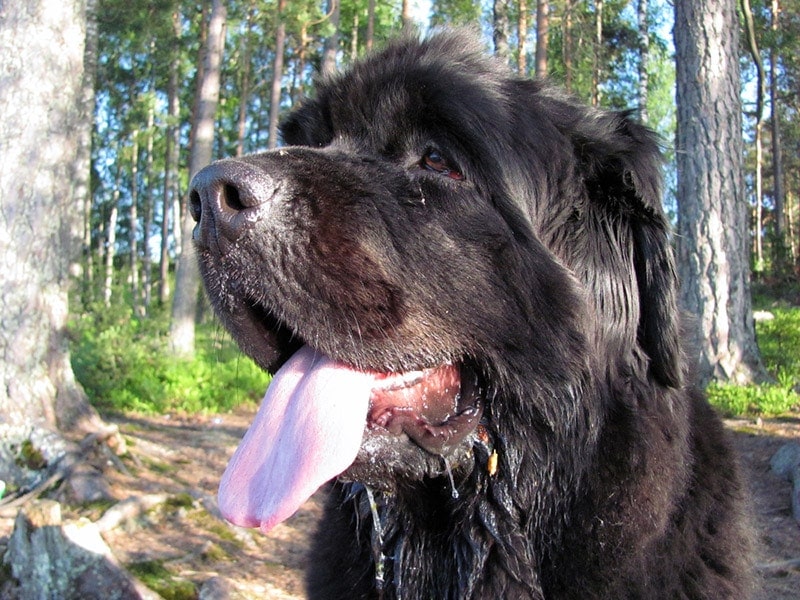
| Origin: | Newfoundland and Labrador, Canada |
| Lifespan: | 9–10 years |
| Height: | 26–28 inches |
| Weight: | 100–150 pounds |
| Drooling Level: | 5/5 |
With this colossal canine on your side, you won’t have to worry about intruders. The Newfoundland will scare them away with a striking demeanor, loud bark, and loads of slime. The second a Newfie becomes anxious, aggressive, or hungry, spit starts to fly from all directions. The deep lips accumulate saliva, and then it drips from the jowls.
To keep the “casualties” to a minimum, we recommend using drool bibs. They don’t cost much but they help with the mess.
5. Neapolitan Mastiff
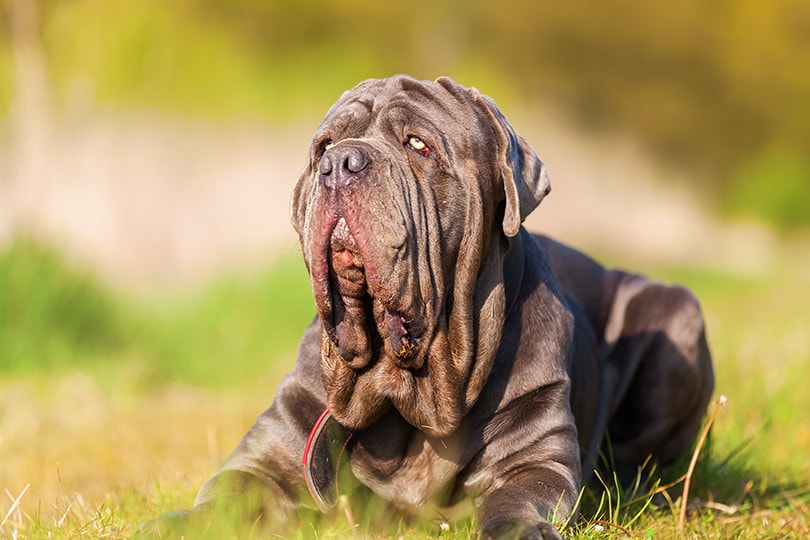
| Origin: | Italy |
| Lifespan: | 7–9 years |
| Height: | 24–31 inches |
| Weight: | 110–150 pounds |
| Drooling Level: | 5/5 |
If you don’t necessarily mind mopping up the floor every day, the Neapolitan Mastiff will be a great choice. Tall and heavy, the Mastino is a dignified, alert, and watchful protector. It takes loyalty and commitment very seriously but can also turn a room into a slobbery disaster. Every time this Italian boy or girl tastes a treat or gets excited, expect streams of saliva to follow.
Physical activity and warm weather will have the same effect. The stretched-out, excessive skin, short muzzle, and large jowls are to blame for that.
6. Basset Hound
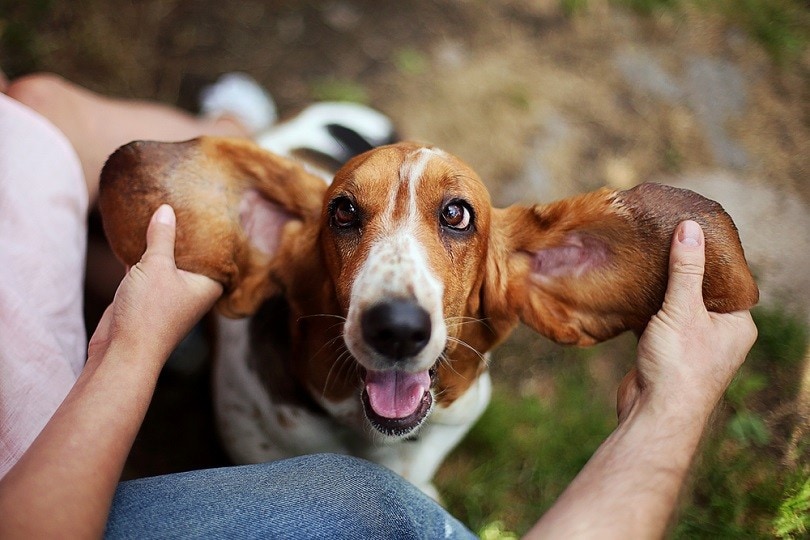
| Origin: | France, Great Britain |
| Lifespan: | 12–13 years |
| Height: | 11–15 inches |
| Weight: | 40–65 pounds |
| Drooling Level: | 4/5 |
It takes a single glimpse at the charming, curious, and playful Basset Hound to fall in love. It does have a stubborn streak, of course (like most intelligent breeds), yet doesn’t take that much effort to train. Also, despite the average-at-best size, Bassets are almost as strong as Mastiffs, Corsos, and Boxers. The mighty bone structure and strong legs turn them into canine royalty.
And let’s not forget about the cute eyes, ears, wrinkled brow, and big nose that’s only second to that of a Bloodhound. The large flews also make Bassets drool like crazy, though.
7. Great Dane
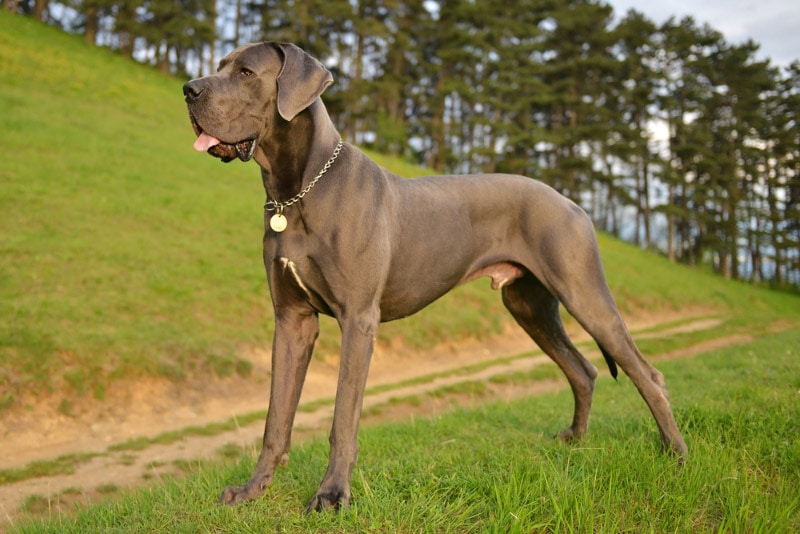
| Origin: | Germany |
| Lifespan: | 7–10 years |
| Height: | 28–32 inches |
| Weight: | 110–175 pounds |
| Drooling Level: | 4/5 |
In contrast to popular belief, Great Danes are native to Germany, not Denmark. These big, powerful dogs create lifelong bonds and prefer a large property over a tiny apartment. Quick to adapt and energetic, Danes can be perfect pets in the right hands. They are elegant, noble, and spirited yet don’t mind covering an expensive chair in slime.
So, if you’re planning on welcoming the “Apollo of Dogs” into your household, make sure you’ve got enough towels to deal with the mess. Again, we have the overhanging flews to blame for that: over time, they collect saliva that the dog then scatters all over the house.
8. Mastiff
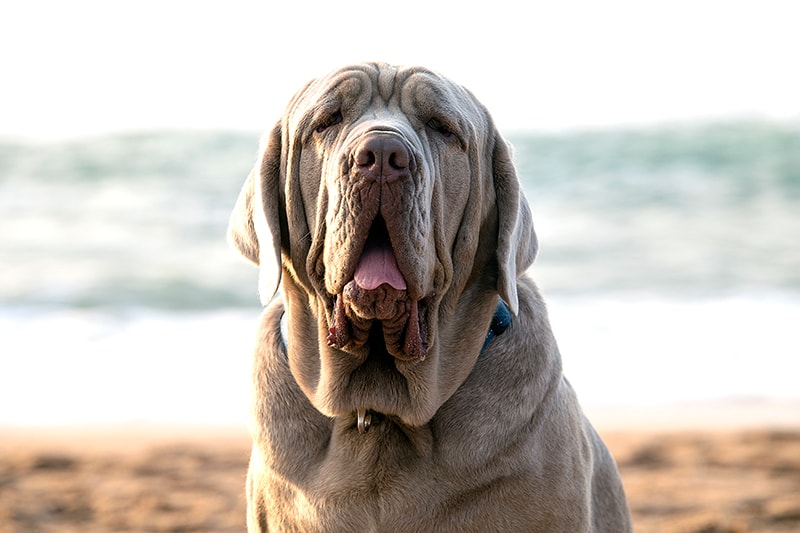
| Origin: | England |
| Lifespan: | 6–10 years |
| Height: | 27–30 inches |
| Weight: | 120–230 pounds |
| Drooling Level: | 4/5 |
Up next, we have a titan of a dog that can weigh up to 230 pounds. You don’t want to get this champ mad! Mastiffs have been around for ages and have a calm, docile, and friendly attitude toward the people they trust. But as a giant breed, the Mastiff drools heavily through the floppy jowls. So, get stocked on towels and stain removers!
And one more thing: most dogs from the Mastiff family tend to drool a lot. This applies to Bullmastiffs, Spanish Mastiffs, and Tibetan Mastiffs.
9. Clumber Spaniel

| Origin: | England |
| Lifespan: | 10–12 years |
| Height: | 17–20 inches |
| Weight: | 55–85 pounds |
| Drooling Level: | 4/5 |
Noble, dignified, and praised by kings and queens, Clumber Spaniels are a mystery. First, they are extremely rare; secondly, it’s almost impossible to track down their roots. But back in the 19th century, Clumber Spaniels were THE dogs of choice among royalty. So, how did they make the list? Well, if you’re thinking about adopting this precious pup, get ready for some shedding and drooling.
While it doesn’t drool as persistently as some of the other breeds, towels will still be in order.
10. Bernese Mountain Dog

| Origin: | Switzerland |
| Lifespan: | 7–10 years |
| Height: | 23–27.5 inches |
| Weight: | 70–115 pounds |
| Drooling Level: | 3/5 |
Much like Saint Bernards, Bernese Mountain Dogs were born and bred in Switzerland. BMDs have a big, loving heart and happily share their joy with humans and animals alike. But are these dogs known to drool, though? Yes, absolutely, but not as much as our top picks for today. If you keep the dog comfy and be quick with your towel game, it shouldn’t be that hard to keep the house clean.
These buds are mostly frowned upon for shedding, by the way, and blow twice a year.
11. Bulldog
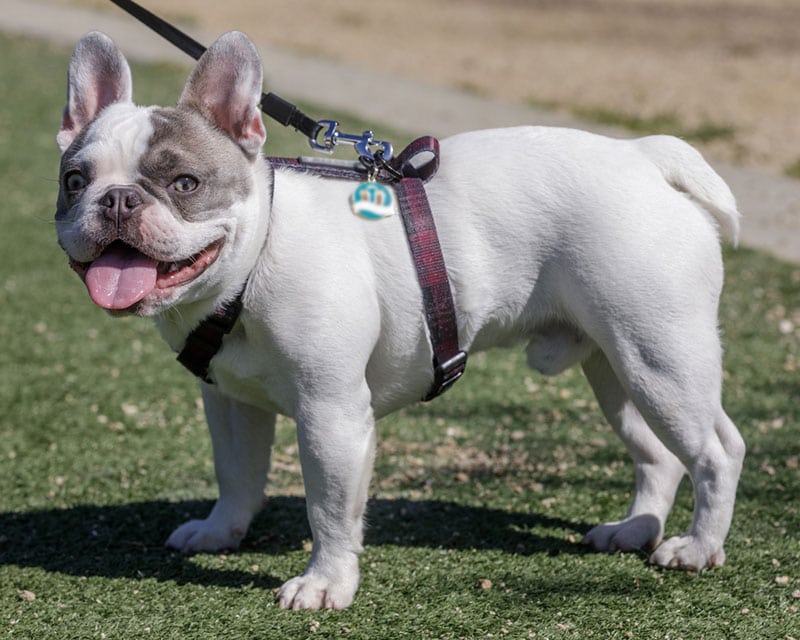
| Origin: | England |
| Lifespan: | 8–10 years |
| Height: | 14–15 inches |
| Weight: | 40–55 pounds |
| Drooling Level: | 3/5 |
These chaps need no introduction: Bulldogs have been a crowd-favored breed for many centuries. And recently, they managed to charm their way to the top. Friendly, eager to make new friends, courageous, and equally cute and menacing, these pups are a real treat. That grumpy, slightly frustrated, yet happy mug is a huge part of their charm.
And, while the snout is nice and compact, the top lip is larger than in most dogs, and that’s what puts these buds on the list. Another thing to keep in mind is that a Bulldog’s coat requires proper maintenance and tends to shed heavily during the season.
12. Boxer
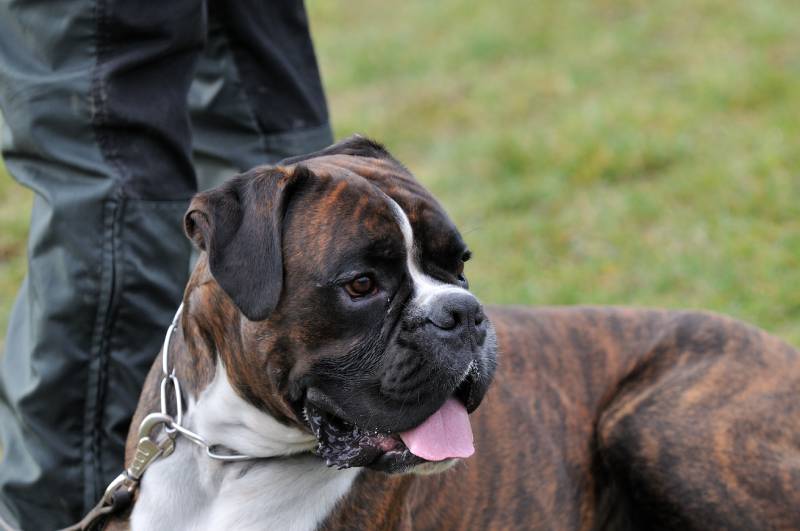
| Origin: | Germany |
| Lifespan: | 10–12 years |
| Height: | 21.5–25 inches |
| Weight: | 50–80 pounds |
| Drooling Level: | 3/5 |
Energetic, joyful, and ready to rumble—that’s the best way to describe the Boxer. This is a faithful, witty, and oh-so-affectionate pet that’s never afraid to be a bit goofy around friends and family. A gifted guardian, a well-trained Boxer can turn into a full-time nanny for your kids (although supervision will be necessary).
As for the drooling, the long jowls instantly tell an experienced dog owner that there’s going to be some slobbering involved. Don’t worry, though: Boxers don’t drool nearly as much as some of the bigger and leaner four-legged champs from the list. This is a relatively smaller dog, too.
13. Chinese Shar-Pei

| Origin: | China |
| Lifespan: | 8–12 years |
| Height: | 18–20 inches |
| Weight: | 45–65 pounds |
| Drooling Level: | 3/5 |
In the mid-20th century, the Shar-Pei almost went extinct. Thankfully, today, China’s unique pups are very much alive and kicking. So, why the sudden spike in popularity? These dogs are independent, well-mannered (yet aloof with strangers), and faithful, which is pretty much what all parents want to see in a pup.
The broad muzzle, tiny eyes, and, of course, the folding skin make this an easily recognizable breed. Moderate drooling will be a part of the picture as well. The moment this bud gets excited (like about a tasty snack, jog around the block, or fun game), it will start generating saliva on a near-industrial scale.
14. Great Pyrenees
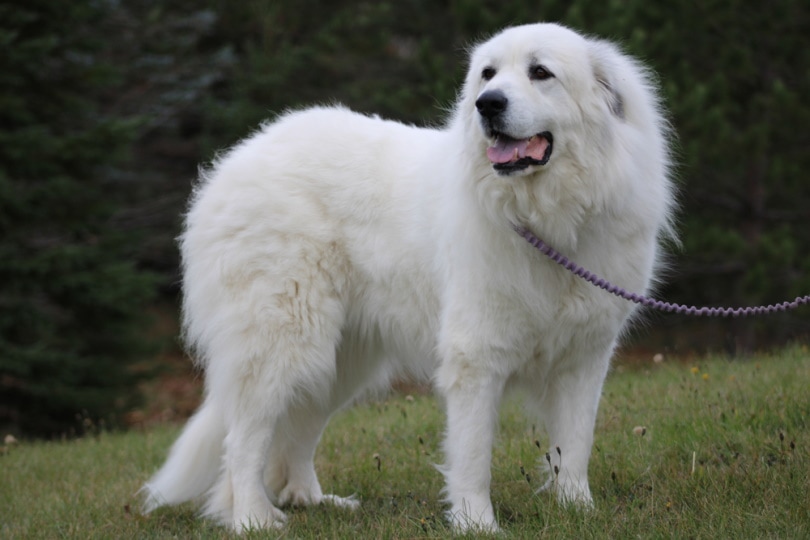
| Origin: | France, Spain |
| Lifespan: | 10–12 years |
| Height: | 25–32 inches |
| Weight: | 85–160 pounds |
| Drooling Level: | 3/5 |
Bred by the mountain people in France and Spain to work as a herding dog, the Great Pyrenees is no stranger to hard work. As a pet, it’s peaceful, intelligent, and observant, yet always ready to hold its own against bigger canines and even wolves. For the most part, Pyrs are low-maintenance pets. But their shedding and drooling levels are slightly above average.
So, see that you have enough brushes, combs, and towels to protect your furniture from turning into a slobbery, hairy mess.
Sudden Excessive Drooling: Most Common Causes
If your pup has always been a moderate drooler, yet now it’s leaving slobber tracks all over the house, it might be dealing with a serious issue.
Should You Be Worried? When Is a Vet Visit Necessary?
Is the dog not showing interest in its favorite snacks? Are you finding it hard now to convince it to go for a walk/play? Noticing any changes in behavioral patterns? If the answer to any of these questions is “yes”, you should seek immediate medical attention for the dog.
Conclusion
Drooling is a natural thing. Most mammals on planet Earth, including humans, produce saliva, and sometimes, it escapes through the mouth. However, none can compete with big, bulky dogs like Saint Bernards, Bloodhounds, or Mastiffs. These imposing chaps drool 24/7 and can make short work of expensive furniture, exotic carpets, and designer clothes.
Some dog parents don’t mind cleaning up the gunk; for others, it’s a living nightmare. Thankfully, not all canines are slobbery: certain breeds keep drooling to a minimum. Yes, it all comes down to adopting the right pet. So, stay away from the slobber-happy dogs from the list, follow our tips on how to minimize/contain drooling, and enjoy your furry bud’s company!
Featured Image Credit: Anton Ogorodov, Shutterstock








